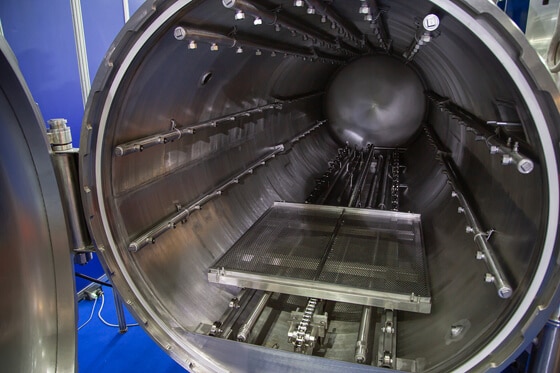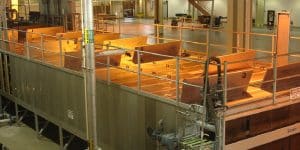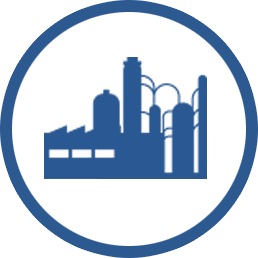
Pasteurization is an important part of food and beverage production process that extends the shelf life of your products and makes sure they are safe to consume. It needs to be done properly to prevent waste and maintain the quality of your product.
Tunnel pasteurizers are very reliable and easy to maintain, but problems such as broken bottles, unclean water, or temperature issues can cause production line stoppages, and equipment failures. These issues can affect the quality of your products, waste production time, and diminish the ability to maintain your capacity.
Continue reading to learn more about the potential problems that can occur.
Downstream Stoppage
In most manufacturing processes, your product goes straight from your pasteurizer to packaging. If there are issues with your packaging process, it can halt pasteurization as well as other parts of your production line.
If you have a downstream stoppage in your packaging process, it can back up your pasteurizer, forcing a stoppage. After a very short time, the product on the belt in the “hot” or PU zones can be ruined. On restart, product that is not properly ramped up to temperature or cooled down may have taste affected.
You’ll need to identify which items haven’t been pasteurized. Product on the belt during a stoppage frequently has to be tossed since they pose a hazard to your consumers. The result is wasted time and lost revenue.
SMT pasteurizers offer assistance to minimize this issue. Our controllers provide a signal to let you know when product being discharged has not been properly processed. We also provide a signal to upstream equipment so an orderly shutdown can be done. We offer “Advanced PU Control” that properly finishes the product in the hot lethal zone, and hold all of the other zones at a safe temperature, and manages the startup so that very little to no product has to be lost during a shutdown.
Downstream Stoppage
If upstream equipment stops, the pasteurizer will continue to run normally. If the stoppage is severe, the temperature of the discharged product will be warmer because there is no regenerative energy available. This is undesirable but not typically a serious problem.
Broken Glass
Many carbonated beverages come in glass bottles that need to be heated and cooled carefully. If they’re overfilled, heated too quickly, or not properly cooled down after being heated for pasteurization, they may pop the top off or burst completely, leaving fluids and broken glass inside your machine.
A well-designed pasteurizer will account for the possibility of broken glass.
For instance, at Smart Machine Technologies, we place screens over pump inlets to keep glass shards from being pulled into the system, limiting the potential damage from broken bottles.
Clean Water
Keeping the water in your pasteurizer clean is essential to proper operation and sanitation. The way you handle cleaning and replacing water in your pasteurizer depends on the size of your unit and how often you run. Small pasteurizers require a different approach from larger units.
Smaller Pasteurizer
Small pasteurizers are usually used in batch processes, not continuous production lines. The water used needs to be changed out regularly, and can’t just be allowed to sit because it makes the perfect breeding ground for microbes.
Typically, the water should be drained after about a week of use, then refilled before you use the pasteurizer next. Again, don’t let the water sit between uses.
Larger Pasteurizer
Larger pasteurizers tend to be part of continuous processes. If you run your pasteurizer continuously, you’ll need to keep a close eye on it to make sure the water is clean. Regularly, check the pH levels of the water used in the system. Your preventive maintenance plan for your pasteurizer should also include using additives to kill off bacteria, remove odors, and so forth.
The water should also be changed out periodically. Often, you can get away with swapping out a third of the water at a time so that it doesn’t interrupt your process too much.
Cleaning Equipment
Any piece of equipment needs to be cleaned regularly, and pasteurizers are no exception.
One of the common challenges with keeping pasteurizers clean is access. With most machines, it can be difficult to get to many of the parts you need to keep clean. Unfortunately, the result of that challenge is that cleaning either doesn’t get done, or it causes excess production downtime to perform correctly.
At Smart Machine Technologies, we make cleaning much easier by including removable panels at key access points and building manways into sumps, allowing for easy access to the equipment. This not only helps with cleaning, but it makes maintenance and repairs much quicker as well.
Failing Heat Exchangers
Pasteurizers often use heat exchangers to heat the water used in the process. Heat exchangers allow heat from one fluid—such as a refrigerant—to pass to another liquid—like water—without the two liquids mixing. If the heat exchanger fails, your pasteurizer won’t heat water, and your pasteurization process won’t make foods or beverages safe for consumption.
This issue is more common with older heat exchangers built from carbon steel, which rusts. The epoxy paint used on these older units can chip over time, exposing the steel to moisture and causing corrosion over time.
SMT only uses stainless steel heat exchangers.
Maintaining Capacity
One primary reason people choose Smart Machine Technologies is that we build to order – and make sure your machine will meet your specific needs.
We build steambox pasteurizers for batch processing, for small batches up to hundreds of bottle per batch.
Issues with maintaining capacity can result from outgrowing your pasteurizer. Your production needs are simply higher than your system can handle. If you’re using a batch pasteurizer, upgrading to a tunnel pasteurizer can help you support the continuous production process you need to maintain capacity.
If you’re ready to step up to a tunnel pasteurizer for inline, continuous operation, we’re happy to build yours for 30 bottles/cans per minute or 600, or anywhere inbetween. Tunnel pasteurizers should be sized for your line production speed, as they run most efficiently when the belt is full. Bottles are more likely to tip and fall on a partially filled belt. Tipped over bottles can roll and jam the belt or break. Typically temperature and speed can be adjusted a bit (10-15%), but a pasteurizer that’s engineered to handle 100 bottles per minute can’t do 300.
We don’t build larger tunnel pasteurizers such as found in major breweries, but we are happy to provide service on them. We’re widely recognized and known for converting from walking beam to belt conveyors, changing belts, replacing sump boxes, servicing pumps, valves, instrumentation and controls.
It’s All About Time and Temperature
In the words of Smart Machine Technologies’ president Glen Moore, “At the end of the day, the key to killing bacteria is time and temperature”. The problems with pasteurization generally come down to making sure your system is reliable in terms of capacity, temperature control, and safety.
If you’re experiencing any of the above problems, contact Smart Machine Technologies for a quote today.





 Contract
Contract Food & Bev
Food & Bev